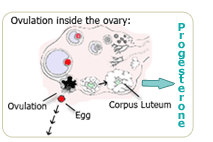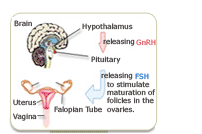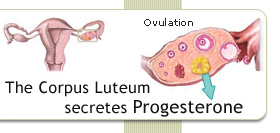34 MENOPAUSE SYMPTOMS |
HEALTH CENTER |
|
| |
|
|
|
|
|
|
|
|
|
Progesterone is a female steroid hormone, or "messenger" molecule that travels through the bloodstream and interacts with a variety of tissues and organs. Progesterone works in tandem with estrogen, but is quite different in that progesterone has no influence on secondary sex characteristics. During the reproductive years, progesterone plays an essential role in the menstrual cycle, fertility, and the maintenance of pregnancy, but the hormone has several other vital functions as well. Keep reading to learn more about progesterone. |
|
|
|
Progesterone hormones are converted from cholesterol in both men and women. In men, the hormone is produced in very low amounts by the adrenal glands and testes. In women, the most important production sites of progesterone are the ovaries and (during pregnancy) the placenta, although the adrenal glands also produce some very low levels of progesterone. |
 |
|
|
|
- Progesterone: The endogenous hormone produced by the ovaries, adrenal glands, placenta or testes.
- Natural progesterone: Bio-identical progesterone hormones (from sources such as wild yam).
- Progestin: Synthetic hormones that have a progesterone-like effect in the body.
|
|
In premenopausal women, progesterone production is closely linked to the menstrual cycle. The ovaries begin to release the progesterone hormone around the time of ovulation, and in the following days produce a rapid upsurge in progesterone levels. In the absence of fertilization, levels of progesterone will begin to decline about ten to twelve days after ovulation, initiating menstruation. After menopause, progesterone production ceases almost entirely (unlike estrogen hormones, which continue to be produced at lower levels).
The primary role of progesterone is in the maintenance of the menstrual cycle and pregnancy, but the hormone also has an impact on several other bodily systems. Inadequate levels of the hormone can have significant affects on health. Keep reading to learn more about the effects of progesterone in the body.  |
|
| |
|

|
|
Progesterone plays role in postpartum depression |
|
Progesterone hormones fluctuate dramatically during and after pregnancy, which has led some researchers to suspect that this may be a fundamental part of the severe depression often experienced after giving birth, says a study published in the British Medical Journal. |
|
|
| |
| |
| |
|
|
|
Falling progesterone levels are an inevitable part of aging, but there are treatment options that can help to stabilize hormonal levels. Keep reading to learn about the most effective treatments for progesterone deficiency, including lifestyle changes, alternative treatments, and medical procedures.
|
|
|
|
|
|
Treating Progesterone Deficiency
with
MacaActive Supplements |
|
Progesterone hormones play an essential role in several areas of the body, and as hormonal levels decline with age, the health implications can be significant. As women begin to notice the symptoms of progesterone deficiency, they may want to consider taking steps to stabilize their hormonal production.
Today, there are three effective ways to normalize hormonal levels: lifestyle changes, alternative medicine and drugs & surgery.
|
|
|
 |
Lifestyle Changes: Lifestyle changes (such as an improved diet and increased exercise) are vital for overall health and for alleviating the symptoms of hormonal balance, but lifestyle changes alone will not have a significant impact on hormonal production. Most women will want to consider the next level of treatment, alternative medicine, which has proven to be excellent for treating progesterone deficiency in a safe and natural way.
|
|
|
 |
Alternative medicine: There are two types of herbal supplements for improving low hormonal levels: those containing phytoestrogenic herbs, and those containing non-estrogenic herbs. Phytoestrogenic herbs (like Black Cohosh) are filled with phytoestrogens, which are similar to estrogens. They can increase low estrogen levels by replacing some of the missing estrogen hormones. This isn't the best solution, however, because your body will become less responsive to producing estrogen on its own, causing a further decrease in body-own hormone levels. Unlike phytoestrogenic herbs, non-estrogenic herbs don't contain estrogen, but they nourish the hormonal glands to work more efficiently. This ultimately results in balancing not only estrogen, but other necessary hormones, as well, including progesterone. Using non-estrogenic herbs is one of the safest and best ways to treat hormonal imbalance naturally.
An excellent example of a safe and effective non-estrogenic herb for progesterone deficiency is herbal MacaActive. What makes MacaActive so special is its ability to balance hormonal levels in women by nourishing the hormonal glands. In this way, it alleviates most disorders related to hormonal imbalance.  to read more about MacaActive.
|
|
|
 |
Drugs and Surgery: This level of treatment has the highest risk and often the highest cost. The most common drug therapy for treating hot flashes in the US is hormone replacement therapy (HRT). There's no doubt that this is the quickest and strongest way to combat hormonal imbalance. Unfortunately, it entails serious side effects and increases the risk of different types of cancer in women. If you still want to consider this approach, see your doctor to learn more about what this treatment option involves.
|
|
|
A safe way for balancing hormones:
Non-estrogenic herbs are the most effective solution for treating progesterone deficiency.
MacaActive is an excellent non-estrogenic herb. It's simple: rather than putting hormones from the outside into your body artificially, MacaActive stimulates your hormone glands into producing the necessary hormones naturally. This is what makes MacaActive supplements so unique.  to read all about MacaActive. |
 |
|
|
 |
|
|
|








